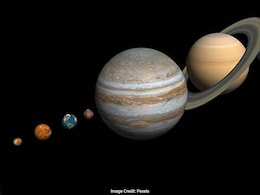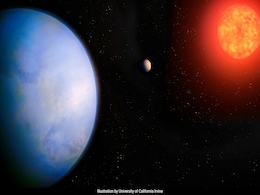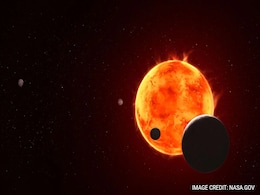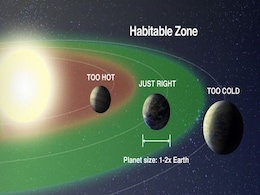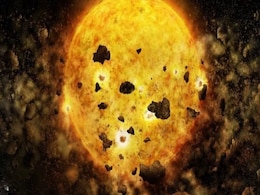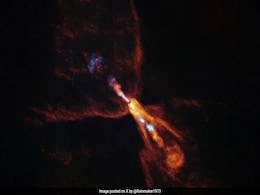Rocky Planet
- All
- News
-

A Nearby Planet May Have Formed the Moon Following a Collision With Early Earth: Study
- Wednesday December 3, 2025
- Written by Gadgets 360 Staff
A new analysis of Apollo samples and Earth rocks suggests that a nearby rocky planet, not a distant object, collided with early Earth and formed the moon. The study argues that this lost planet, Theia, originated in the inner solar system and shared Earth’s early neighbourhood, offering fresh insight into one of the most important events in our p...
-
 www.gadgets360.com
www.gadgets360.com
-

NASA's James Webb Space Telescope Telescope Challenges Old Theories on Mini-Neptune Worlds
- Friday November 7, 2025
- Written by Gadgets 360 Staff
New models suggest mini-Neptunes—planets smaller than Neptune with thick gas envelopes—may have solid rocky surfaces instead of molten magma. Data from NASA’s JWST revealed high-pressure atmospheres capable of compressing molten rock into solid crusts. This discovery challenges earlier assumptions and offers key insights into exoplanet compos...
-
 www.gadgets360.com
www.gadgets360.com
-

Possible 'Super-Earth' Discovered Just 20 Light-Years Away, Say Scientists
- Saturday October 25, 2025
- Science | Edited by Nikhil Pandey
The rocky exoplanet is nearly four times Earth's mass and may offer new insights in the search for habitable worlds.
-
 www.ndtv.com
www.ndtv.com
-

Astronomers Detect Hints Of Hidden Earth-Sized Planet Beyond Neptune
- Wednesday October 15, 2025
- Written by Gadgets 360 Staff
Astronomers propose the existence of ‘Planet Y’, a hidden Earth-size planet that may orbit closer than the theorized ‘Planet Nine’. Based on Kuiper Belt object patterns, the study suggests a rocky world influencing orbital tilts. Experts remain divided, but upcoming sky surveys could soon confirm or rule out its existence.
-
 www.gadgets360.com
www.gadgets360.com
-

Not Like Venus Or Mars, Distant Exoplanet May Have Atmosphere Like Earth's
- Friday September 19, 2025
- World News | Edited by NDTV News Desk
A distant exoplanet might have an atmosphere similar to Earth's, early observations from the James Webb Space Telescope (JWST) suggest. It is part of a group of planets orbiting a star called TRAPPIST-1, about 40 light-years away from Earth.
-
 www.ndtv.com
www.ndtv.com
-

Mercury Has Shrunk by Several Kilometers Over Billions of Years, Scientists Report
- Tuesday August 19, 2025
- Written by Gadgets 360 Staff
Mercury’s surface reveals it has been shrinking for billions of years due to cooling and faulting. A new study estimates the planet’s radius has contracted by 2.7–5.6 kilometers, offering the most precise figures yet. The findings sharpen understanding of Mercury’s thermal evolution and could help scientists apply the same techniques to tec...
-
 www.gadgets360.com
www.gadgets360.com
-

Habitable Zone Explained: The ‘Goldilocks Zone’ Where Life-Friendly Planets May Exist
- Tuesday August 12, 2025
- Written by Gadgets 360 Staff
The habitable zone, or “Goldilocks zone”, is the region around a star where conditions allow liquid water to exist. Varying with star type, this zone is key in the search for life. Earth’s location in the Sun’s habitable zone has made life possible, and astronomers seek similar rocky exoplanets in other systems to explore the possibility of...
-
 www.gadgets360.com
www.gadgets360.com
-

Doomed Exoplanet TOI-2109b Spirals Toward Its Star with Three Possible Fates
- Monday July 28, 2025
- Written by Gadgets 360 Staff
The gas giant TOI-2109b, over five times Jupiter’s mass, is spiraling closer to its star in a rare planetary death spiral. With a 16-hour orbit and blistering heat, the exoplanet could either plunge into its host star, be torn apart by tidal forces, or evolve into a rocky super-Earth through photoevaporation. NASA’s TESS and ESA’s Cheops data...
-
 www.gadgets360.com
www.gadgets360.com
-

Chandra Spots Distant Baby Planet Losing Its Atmosphere Under Intense X-ray Assault
- Saturday July 19, 2025
- Written by Gadgets 360 Staff
NASA’s Chandra X-ray Observatory has captured a rare glimpse of TOI 1227 b, a young, Jupiter-sized exoplanet losing its atmosphere under intense stellar radiation. Just 8 million years old, the planet is shrinking rapidly as X-rays strip away its mass. Scientists warn it may become a barren rocky core in about a billion years.
-
 www.gadgets360.com
www.gadgets360.com
-

Young Exoplanet Spotted Shedding Atmosphere Under Stellar Radiation
- Thursday July 17, 2025
- Written by Gadgets 360 Staff
NASA’s Chandra X-ray Observatory and Hubble Space Telescope have captured a dramatic cosmic event: a baby exoplanet, TOI 1227 b, is being stripped of its atmosphere by powerful X-rays from its host star. Only 8 million years old and orbiting a red dwarf, this Jupiter-sized planet is losing gas at a rate equal to Earth’s entire atmosphere every ...
-
 www.gadgets360.com
www.gadgets360.com
-

Astronomers Capture Planet Birth Around Baby Sun Outside Solar System
- Thursday July 17, 2025
- World News | Associated Press
Astronomers have discovered the earliest seeds of rocky planets forming in the gas around a baby sun-like star, providing a precious peek into the dawn of our own solar system.
-
 www.ndtv.com
www.ndtv.com
-

Did Something Hit Saturn? Astronomers Investigate Possible Impact Flash
- Wednesday July 9, 2025
- Science | Edited by Amit Chaturvedi
Unlike rocky planets where asteroid impacts leave visible craters, gas giants like Saturn have outer layers of hydrogen and helium that can absorb impacts without obvious traces.
-
 www.ndtv.com
www.ndtv.com
-

Meteorite From Outer Solar System Challenges Planet Formation Timeline in Early Solar System
- Saturday July 12, 2025
- Written by Gadgets 360 Staff
A meteorite from the outer solar system may upend long-held beliefs about planetary formation. New research shows rocky planets like Earth may have formed at the same time as those beyond Jupiter. The findings challenge previous models and suggest a more synchronised origin for rocky worlds across the solar system, with major implications for plane...
-
 www.gadgets360.com
www.gadgets360.com
-

A Nearby Planet May Have Formed the Moon Following a Collision With Early Earth: Study
- Wednesday December 3, 2025
- Written by Gadgets 360 Staff
A new analysis of Apollo samples and Earth rocks suggests that a nearby rocky planet, not a distant object, collided with early Earth and formed the moon. The study argues that this lost planet, Theia, originated in the inner solar system and shared Earth’s early neighbourhood, offering fresh insight into one of the most important events in our p...
-
 www.gadgets360.com
www.gadgets360.com
-

NASA's James Webb Space Telescope Telescope Challenges Old Theories on Mini-Neptune Worlds
- Friday November 7, 2025
- Written by Gadgets 360 Staff
New models suggest mini-Neptunes—planets smaller than Neptune with thick gas envelopes—may have solid rocky surfaces instead of molten magma. Data from NASA’s JWST revealed high-pressure atmospheres capable of compressing molten rock into solid crusts. This discovery challenges earlier assumptions and offers key insights into exoplanet compos...
-
 www.gadgets360.com
www.gadgets360.com
-

Possible 'Super-Earth' Discovered Just 20 Light-Years Away, Say Scientists
- Saturday October 25, 2025
- Science | Edited by Nikhil Pandey
The rocky exoplanet is nearly four times Earth's mass and may offer new insights in the search for habitable worlds.
-
 www.ndtv.com
www.ndtv.com
-

Astronomers Detect Hints Of Hidden Earth-Sized Planet Beyond Neptune
- Wednesday October 15, 2025
- Written by Gadgets 360 Staff
Astronomers propose the existence of ‘Planet Y’, a hidden Earth-size planet that may orbit closer than the theorized ‘Planet Nine’. Based on Kuiper Belt object patterns, the study suggests a rocky world influencing orbital tilts. Experts remain divided, but upcoming sky surveys could soon confirm or rule out its existence.
-
 www.gadgets360.com
www.gadgets360.com
-

Not Like Venus Or Mars, Distant Exoplanet May Have Atmosphere Like Earth's
- Friday September 19, 2025
- World News | Edited by NDTV News Desk
A distant exoplanet might have an atmosphere similar to Earth's, early observations from the James Webb Space Telescope (JWST) suggest. It is part of a group of planets orbiting a star called TRAPPIST-1, about 40 light-years away from Earth.
-
 www.ndtv.com
www.ndtv.com
-

Mercury Has Shrunk by Several Kilometers Over Billions of Years, Scientists Report
- Tuesday August 19, 2025
- Written by Gadgets 360 Staff
Mercury’s surface reveals it has been shrinking for billions of years due to cooling and faulting. A new study estimates the planet’s radius has contracted by 2.7–5.6 kilometers, offering the most precise figures yet. The findings sharpen understanding of Mercury’s thermal evolution and could help scientists apply the same techniques to tec...
-
 www.gadgets360.com
www.gadgets360.com
-

Habitable Zone Explained: The ‘Goldilocks Zone’ Where Life-Friendly Planets May Exist
- Tuesday August 12, 2025
- Written by Gadgets 360 Staff
The habitable zone, or “Goldilocks zone”, is the region around a star where conditions allow liquid water to exist. Varying with star type, this zone is key in the search for life. Earth’s location in the Sun’s habitable zone has made life possible, and astronomers seek similar rocky exoplanets in other systems to explore the possibility of...
-
 www.gadgets360.com
www.gadgets360.com
-

Doomed Exoplanet TOI-2109b Spirals Toward Its Star with Three Possible Fates
- Monday July 28, 2025
- Written by Gadgets 360 Staff
The gas giant TOI-2109b, over five times Jupiter’s mass, is spiraling closer to its star in a rare planetary death spiral. With a 16-hour orbit and blistering heat, the exoplanet could either plunge into its host star, be torn apart by tidal forces, or evolve into a rocky super-Earth through photoevaporation. NASA’s TESS and ESA’s Cheops data...
-
 www.gadgets360.com
www.gadgets360.com
-

Chandra Spots Distant Baby Planet Losing Its Atmosphere Under Intense X-ray Assault
- Saturday July 19, 2025
- Written by Gadgets 360 Staff
NASA’s Chandra X-ray Observatory has captured a rare glimpse of TOI 1227 b, a young, Jupiter-sized exoplanet losing its atmosphere under intense stellar radiation. Just 8 million years old, the planet is shrinking rapidly as X-rays strip away its mass. Scientists warn it may become a barren rocky core in about a billion years.
-
 www.gadgets360.com
www.gadgets360.com
-

Young Exoplanet Spotted Shedding Atmosphere Under Stellar Radiation
- Thursday July 17, 2025
- Written by Gadgets 360 Staff
NASA’s Chandra X-ray Observatory and Hubble Space Telescope have captured a dramatic cosmic event: a baby exoplanet, TOI 1227 b, is being stripped of its atmosphere by powerful X-rays from its host star. Only 8 million years old and orbiting a red dwarf, this Jupiter-sized planet is losing gas at a rate equal to Earth’s entire atmosphere every ...
-
 www.gadgets360.com
www.gadgets360.com
-

Astronomers Capture Planet Birth Around Baby Sun Outside Solar System
- Thursday July 17, 2025
- World News | Associated Press
Astronomers have discovered the earliest seeds of rocky planets forming in the gas around a baby sun-like star, providing a precious peek into the dawn of our own solar system.
-
 www.ndtv.com
www.ndtv.com
-

Did Something Hit Saturn? Astronomers Investigate Possible Impact Flash
- Wednesday July 9, 2025
- Science | Edited by Amit Chaturvedi
Unlike rocky planets where asteroid impacts leave visible craters, gas giants like Saturn have outer layers of hydrogen and helium that can absorb impacts without obvious traces.
-
 www.ndtv.com
www.ndtv.com
-

Meteorite From Outer Solar System Challenges Planet Formation Timeline in Early Solar System
- Saturday July 12, 2025
- Written by Gadgets 360 Staff
A meteorite from the outer solar system may upend long-held beliefs about planetary formation. New research shows rocky planets like Earth may have formed at the same time as those beyond Jupiter. The findings challenge previous models and suggest a more synchronised origin for rocky worlds across the solar system, with major implications for plane...
-
 www.gadgets360.com
www.gadgets360.com




